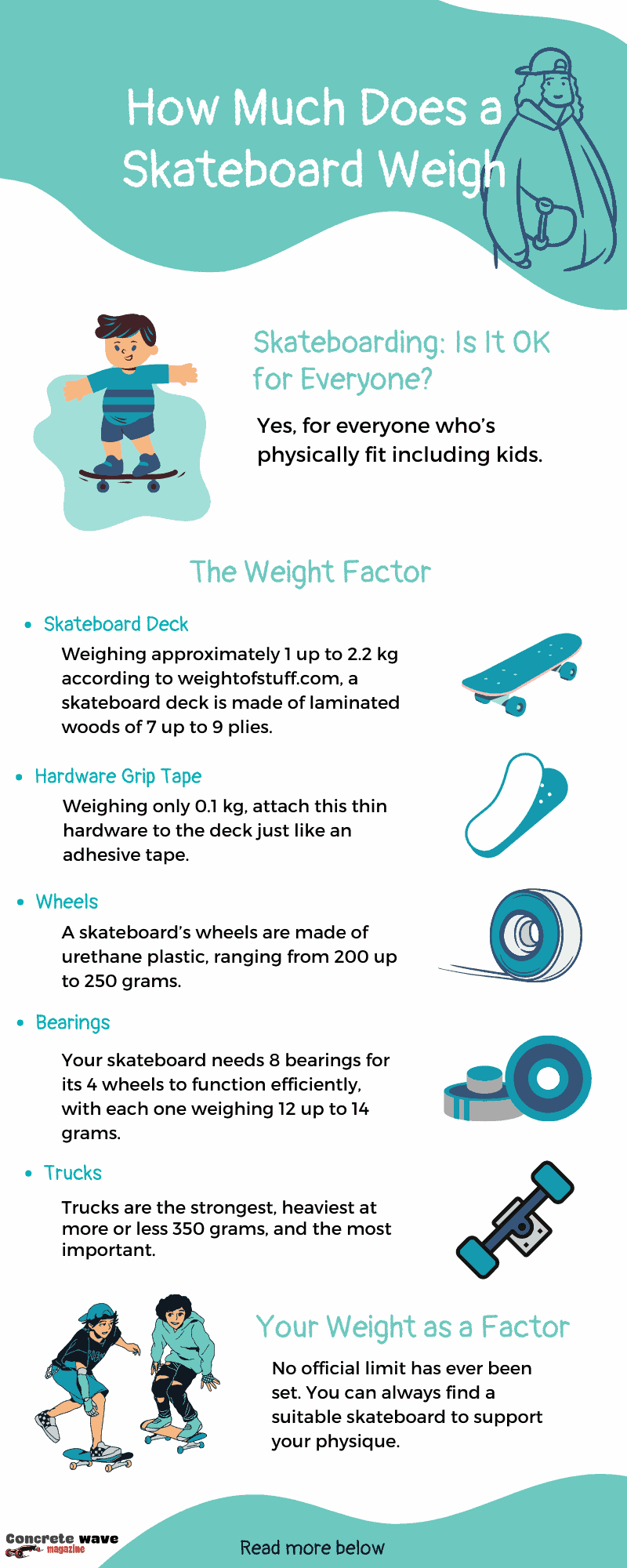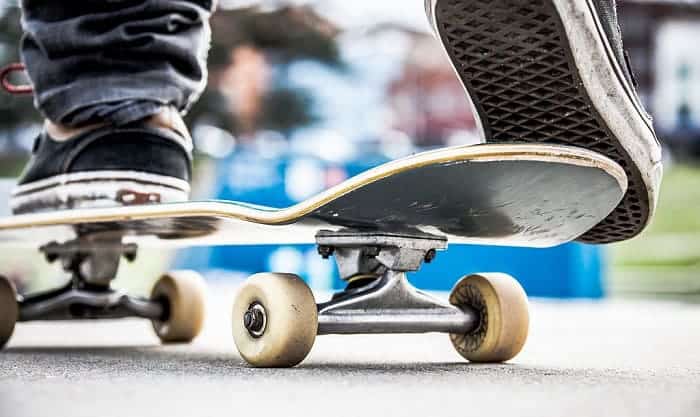How much does a skateboard weigh? Does a skateboard’s weight affect its strength? Is it possible to do as many tricks with both light and heavy skateboards? Does my own weight have an impact on my performance?
If you’re passionate about skateboarding or interested in it as a hobby, you’ll benefit from the answers to these questions. I’ve also tackled the issue which many people have been asking: Are there limits to a skateboard’s and skateboarder’s weight? You’ll find the facts in this article very liberating.
Table of Contents
Skateboarding: Is It OK for Everyone?
The world saw its first skateboard at the beginning of the 20th century – a crude box with roller skate wheels. At the time, it was meant to relieve the boredom of surfers who had to wait for rolling waves.
But soon, this so-called “sidewalk surfing” evolved into a sport, recreation, even an art that captured the passion and admiration of millions around the world.
Now, you don’t have to be a surfer to experience the excitement of skateboarding. Likewise, you don’t have to be a skilled skateboarder to benefit from this activity.
Does that mean that skateboarding is ok for everyone?
Yes, for everyone who’s physically fit including kids. After all, skateboards now also serve as a popular mode of transportation. Yet we must also remember that skateboards have their limitations, too. They can snap under too much strain and weight.
The Weight Factor
First, let’s discuss a skateboard’s weight and how this affects its performance and strength.
While there’s no official limit to a skateboard’s weight, a regular board may weigh from 3.1 up to 5 kilograms (7-11 pounds).
A longboard that is used for transport, cruising, and downhill races range from 3.6 up to 5 kilograms (8-11 pounds). An electric skateboard (e-board), on the other hand, weighs up to more than 12 kilograms due to its battery and electric motor.
Light skateboards, while easier to maneuver and to execute tricks with, are known to snap easily. Heavy boards, while having less maneuverability, have the capacity to carry heavier riders and to absorb more impacts.
However, you should bear in mind that it’s not the overall weight that determines a board’s lifespan. Its parts — like deck and trucks with their respective weights and other measurements — play major roles in a skateboard’s level of speed, maneuverability, and endurance.
Skateboard Deck
Weighing approximately 1 up to 2.2 kg according to weightofstuff.com, a skateboard deck is made of laminated woods of 7 up to 9 plies. It’s usually constructed with maplewood. Others are made of bamboo and plastic.
However, several manufacturers now produce decks consisting of carbon fiber and composite woods to make stronger and lighter skateboards. On its part, Element has adopted featherlight technology to come up with Helium that’s currently recognized as one of the most durable skateboard decks on the planet)
Yet, it’s not just weight that matters in choosing the right deck but width as well. Ranging from 7.25 to 8.5 inches, a narrower deck is best suited for performing tricks due to easy maneuverability. On the other hand, a wider deck offers more stability to a rider who’s into street skating and downhill racing.
Other considerations in choosing the proper deck width and length are your age, physique, and foot size. Deck length is measured from its nose to tail, which you must know are the slightly upturned tips that serve as a rider’s kicktails. Skateboard decks can be as long as 29 up to 33 inches.
Hardware Grip Tape
Yes, this is where a skateboard aesthetic appeal comes from. But, in spite of its spectrum of eye-catching colors and designs, the main function of the grip tape is to keep a rider’s feet secure on the skateboard through its rough surface. Weighing only 0.1 kg, you attach this thin hardware to the deck just like an adhesive tape.
Wheels
A skateboard’s wheels are made of urethane plastic, known for its elasticity and durability. Just like in deck selection, you choose a wheel’s size based on your skateboarding style.
Ranging from 200 up to 250 grams, you should opt for smaller wheels if you love doing flips and other tricks with your skateboard. Meanwhile, for those who enjoy street skateboarding and more stable rides, bigger and harder wheels are the more practical choice.
Bearings
Your skateboard needs 8 bearings for its 4 wheels to function efficiently, with each one weighing approximately 12 up to 14 grams. These small discs are either made from steel or ceramic, with the latter stronger and lighter than the former.
Bearings support the wheels on the axle as they roll on the ground or other surfaces. The lighter the bearings, the faster a wheel rolls.
Trucks
Among all skateboard parts, trucks are the strongest, heaviest at more or less 350 grams, and the most important. Attached underneath the deck with the wheels, these are the hardware that carry the weights of both skateboard and rider. Not only that, these parts are designed to absorb skateboarding pressures and impacts efficiently.
Made of powerful metals like titanium, steel, magnesium, and aluminum, trucks have many components to support their functions. These are:
- Base plate
- Hanger
- Pivot cup
- Axles
- Axle nuts
- Kingpin
- Kingpin nut
- Speed rings
- Washers
- Bushings
- Bushing seats
Trucks also come in various heights: low, medium or standard, and high. Just like the decks and the wheels, you choose the size of your trucks according to your skateboarding style.
Based on the recommendations of SkateboardersHQ, low trucks are suited for technical skateboarding, in which you can expect them to be stable even at higher speed levels.
Medium trucks are efficient for both street and transition skateboarding. Meanwhile, higher trucks offer more adrenaline-pumping adventures through vertical, ramp, and bowl skateboarding.
If, just like many riders, you want to customize your skateboard, there are 2 brands that are trusted the most for their trucks. These are Independent and Thunder, which are both available on Amazon.
Your Weight as a Factor
After clearing up the matter of a skateboard’s weight and the significance of a rider’s skateboarding style, let’s go to the next important question. Is there a limit to a skateboarder’s weight?
Well, there are various weight recommendations from manufacturers and professionals but no official limit has ever been set.
The Republic of Skaters provides the following guidelines:
- Skateboard: 100 kg (220 lbs)
- Longboard: 136 kg (300 lbs)
- E-board: 150 kg (330 lbs)
Nevertheless, many experts advise that regardless of your weight you should pursue skateboarding if it’s really your interest. You can always find a suitable skateboard to support your physique. Your weight may prevent you from doing certain techniques, but you can still enjoy many other activities with your board.
Conclusion
Yes, if skateboarding is your passion, you shouldn’t let technicalities hold you back. The answer to how much does a skateboard weigh is not everything. Select your equipment, practice, and keep on experimenting until you find the right board for you.
Get inspired by the history of legendary skateboarders, or watch popular skateboarding videos on YouTube. You’ll be amazed to discover the many odds that the human spirit is able to conquer.

I am Michael, and I have been enjoying this fun sport for seven years. And nothing is better than having a community to share our passion for those thrilling tricks. I am ready to tell you all I know about skateboarding, showing you how to choose a good board and trick to start and how the practice goes. Stay tuned!





